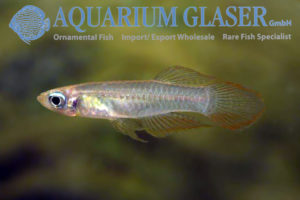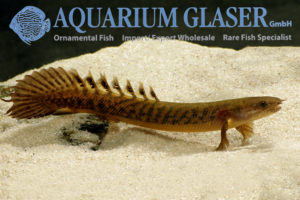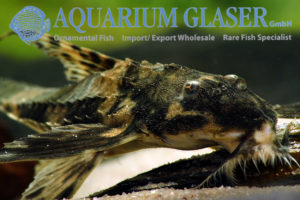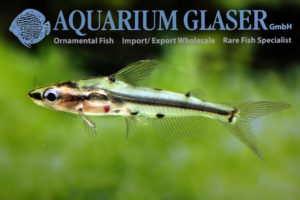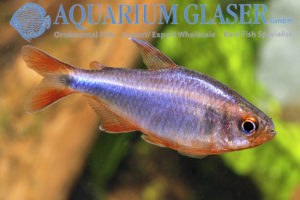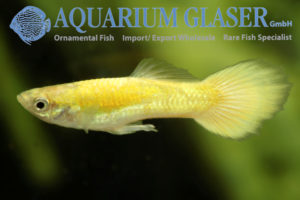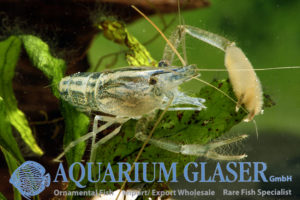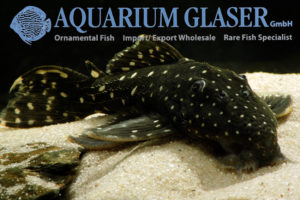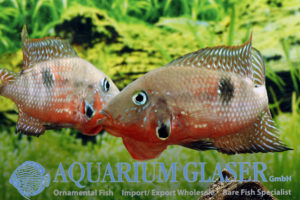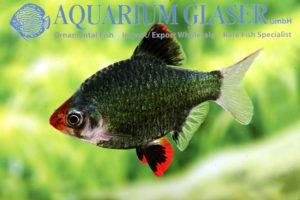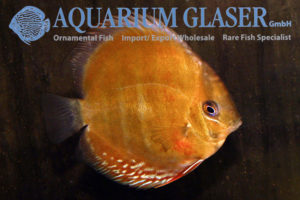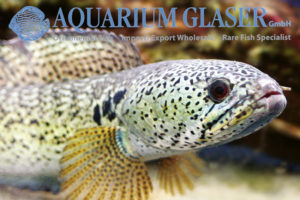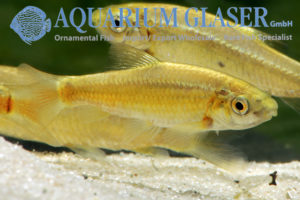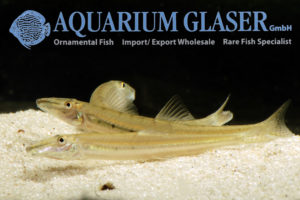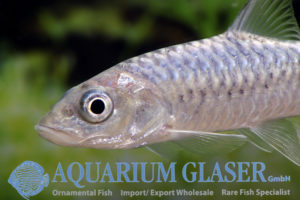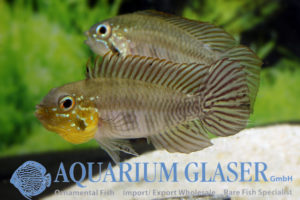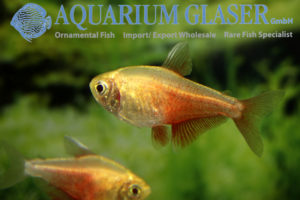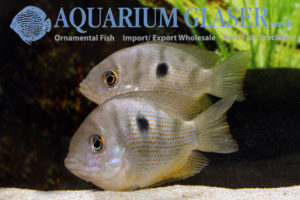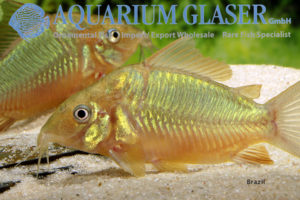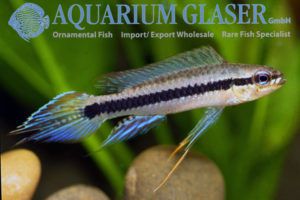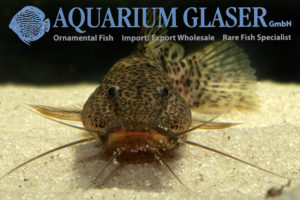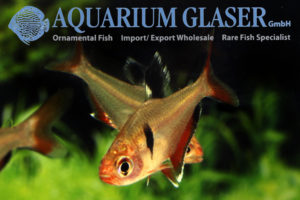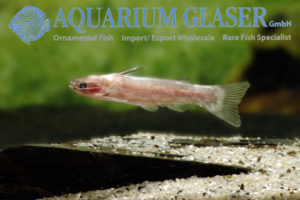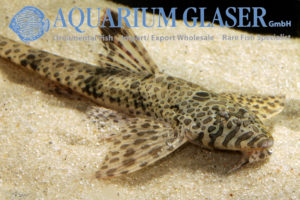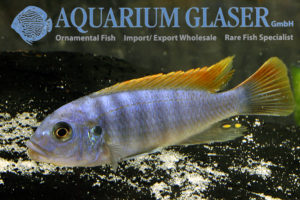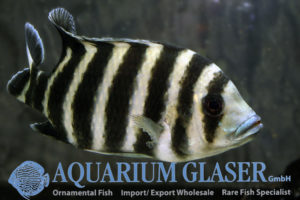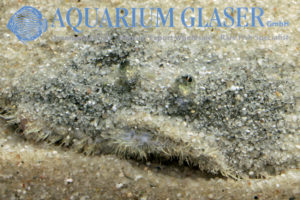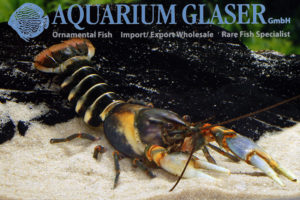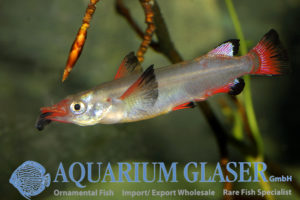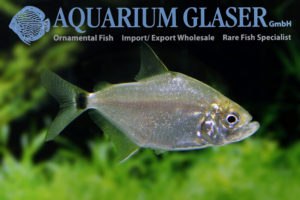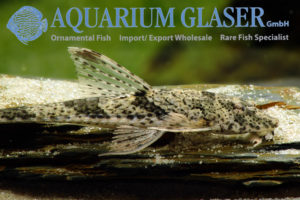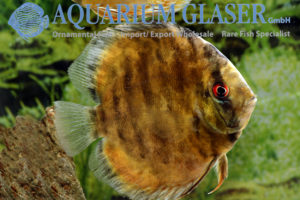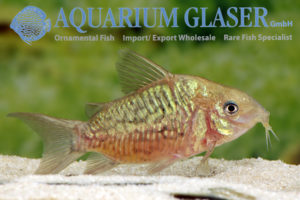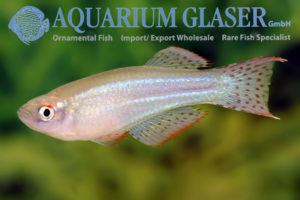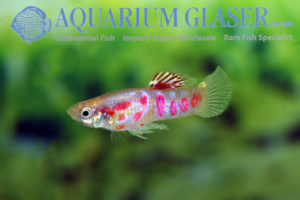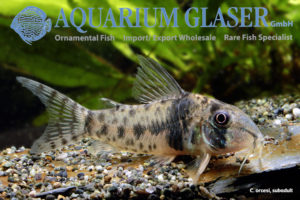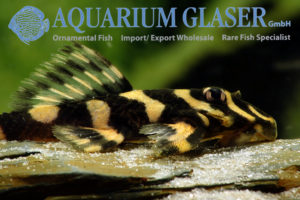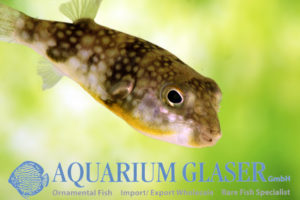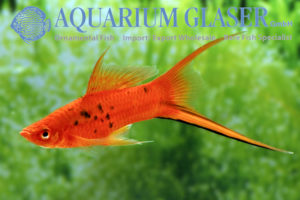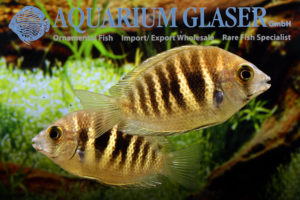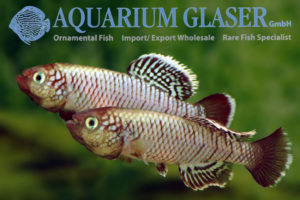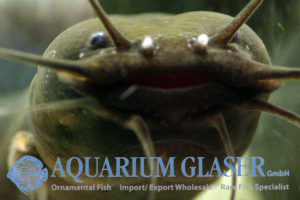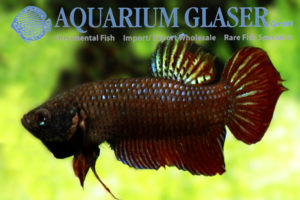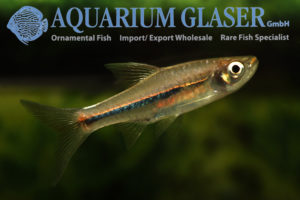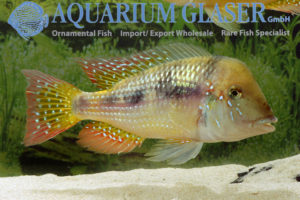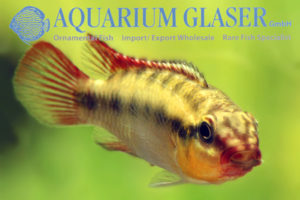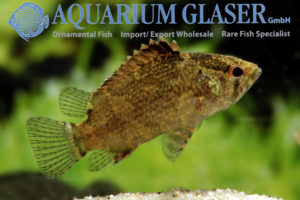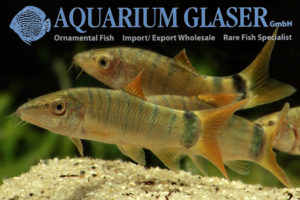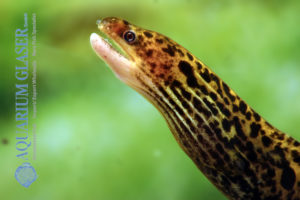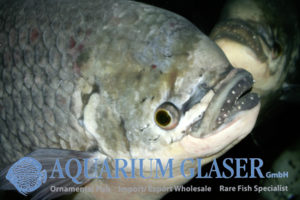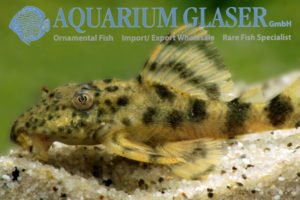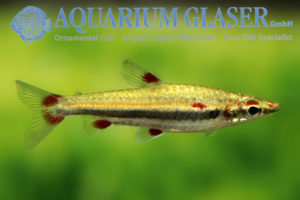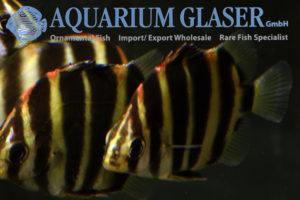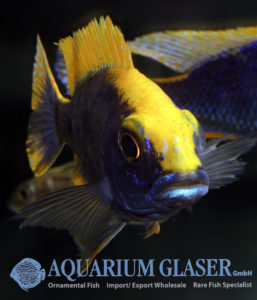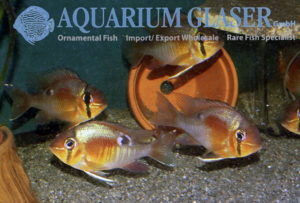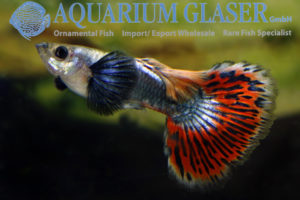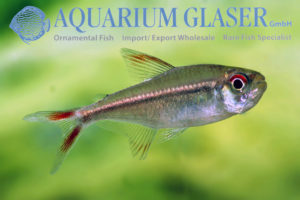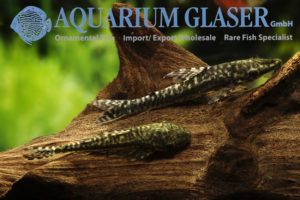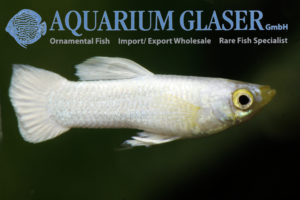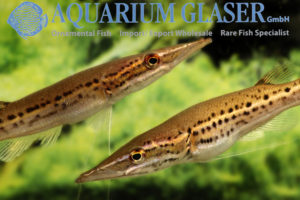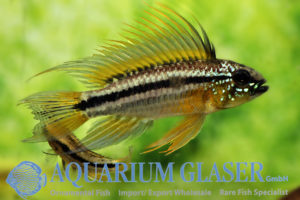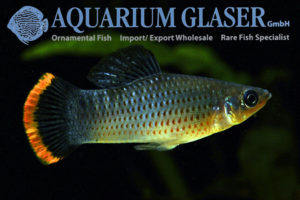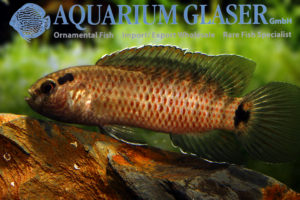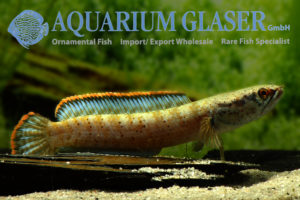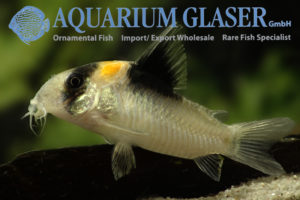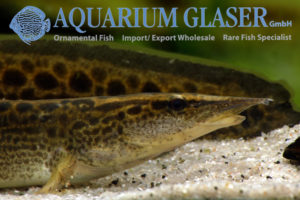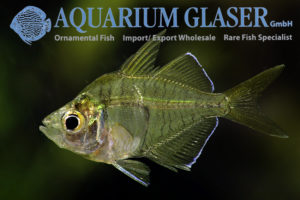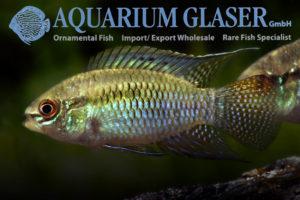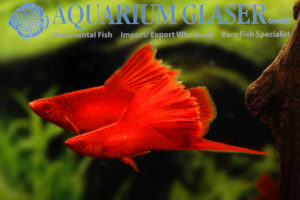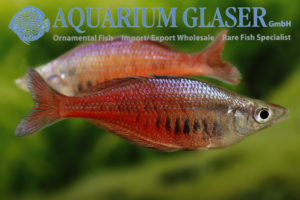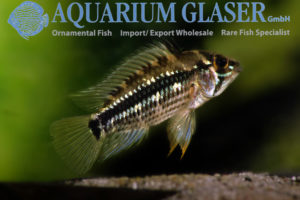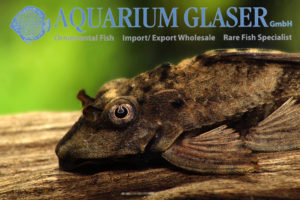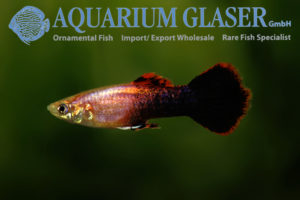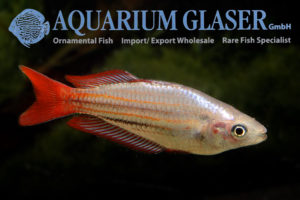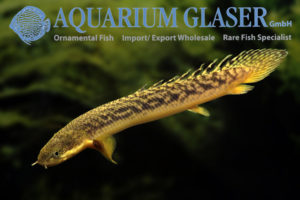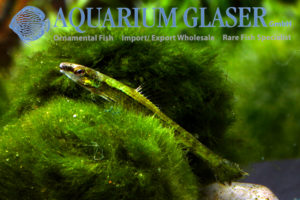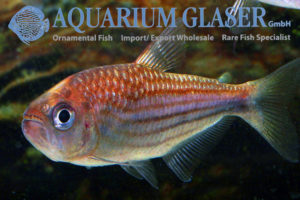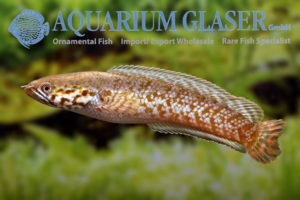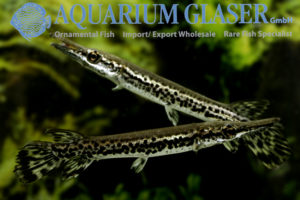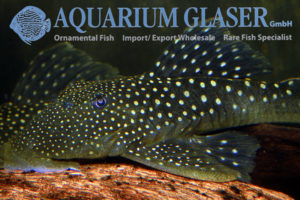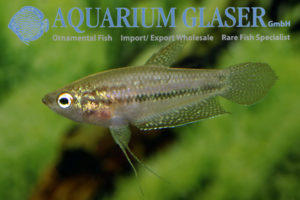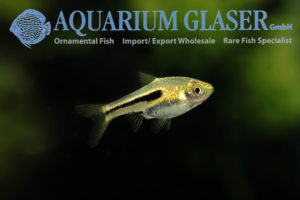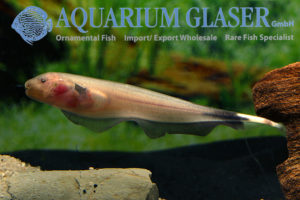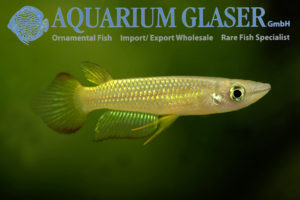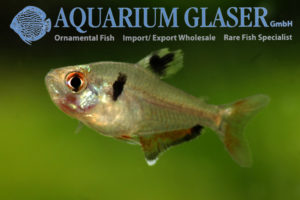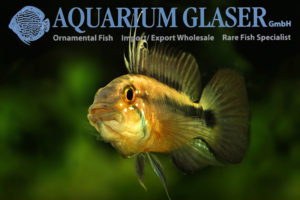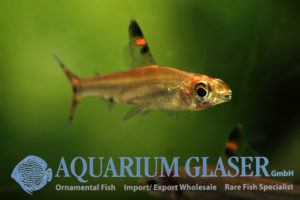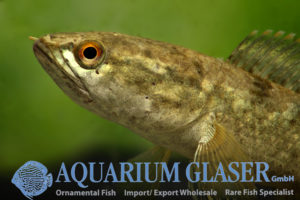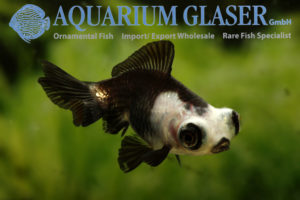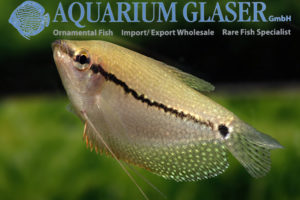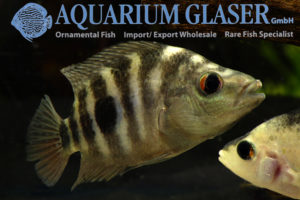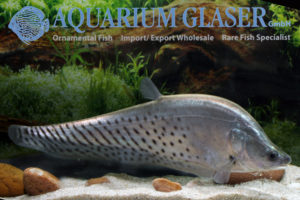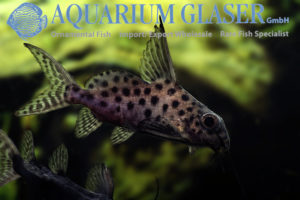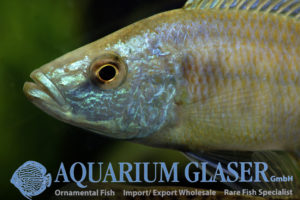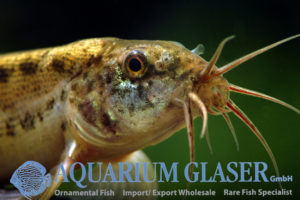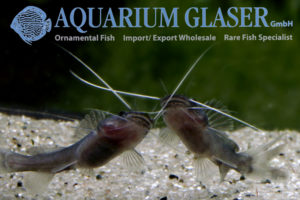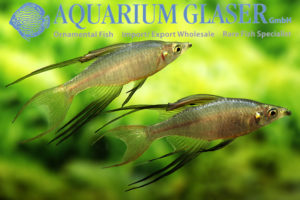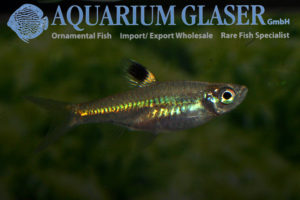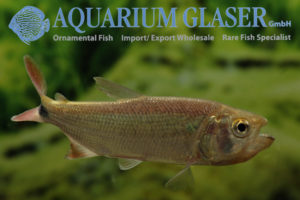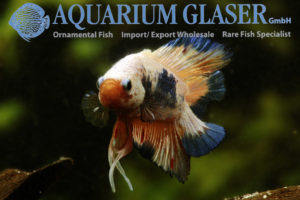A real classic among the species of fish that Takashi Amano preferred to use for his legendary nature aquaria setups is Aplocheilichthys normani (= Poropanchax normani). A single specimen of that lampeye is a rather drab creature, but a larger school of them in a tank with dimmed light is like magic! The blue eyes […]
Fish Archive (2977)
-
-
Polypterus teugelsi Bred
The Cross river in Western Africa is a legendary river. The course of the river starts in Cameroon, the lower part flows through Nigeria. The river is famous for its high degree of endemic species; „endemic“ means that the species occurs only there and nowhere else. Among the endemic species are for example Tetraodon pustulatus […]
-
Brochiloricaria macrodon
We received from Paraguay this wonderful mouthbrooding whiptail catfish. Once we had this species even as bred ones in stock – many years ago. In our recent import the prolongations of the fins are very obvious. This reminds a bit in Lamontichthys. However, Brochiloricaria has a completely different mouth structure and feeding habit. Brochiloricaria are […]
-
Hyalobagrus flavus
Back in 1903 Georg Duncker from the Hamburg Museum described a small species of catfish from the Malay Peninsula under the name of Pseudobagrus ornatus. The description appeared in the same famous paper in which the harlequin barb (Trigonostigma heteromorpha) and the dwarf rasbora (Boraras maculatus) were described. In contrast to the two barbs, which […]
-
Hyphessobrycon wadai
We are very glad to be able to offer this beautiful tetra for the first time now. The fish are German bred ones. The species has been described only in 2016. The natural distribution is the upper basin of the Rio Tapajós. This tetra is already a popular aquarium fish in Sao Paulo (Brazil) since […]
-
Guppy Platinum Gold
The latest creation from the jewellery Sri Lanka: Platinum Gold. This fish is a further development of the Guppy Full Platinum, which we obtained in August, also from Sri Lanka. The yellow or golden coloration differs a lot individually in the Platinum Gold. Some specimens look like the Full Platinum, just with a yellowish tinge, […]
-
Macrobrachium scabriculum
We have obtained once more beautiful chameleon shrimps (Macrobrachium scabriculum) from India. The common name for that species has been given by Uwe Werner due to the change of the basic coloration during the life. Initially these shrimps are translucent, then they usually become blueish, then brownish and finally almost black. Only the contrasting stripe […]
-
Leporacanthicus sp. L326
This unusual Leporacanthicus originates from the Orinoco. The L-number was given already back in 2002. Initially the fish was imported from Colombia. It is said that these fish were collected in the area around Puerto Carreño. We currently received this fish for the first time ever; our specimens come from Venezuela. L326 differs from all […]
-
Thorichthys meeki
The Firemouth (Thorichthys meeki, formerly Cichlasoma meeki) originates from Mexico and belongs to the most popular cichlids at all. This popularity is not at least due to the impressive face mask of the species. No other species of cichlid shows in such perfectness the bottom of the mouth and the deep red skin that covers […]
-
Puntigrus anchisporus „Moss Green“
Many people will still know the tiger barb under the wrong name Barbus or Puntius tetrazona. This species – the correct name is Puntigrus tetrazona – is, however, never kept in aquaria or traded, but exclusively the close relative Puntigrus anchisporus. Both species can be easily distinguished from each other by the colour of the […]
-
Madeira-Discus arrived!
There are so many varieties of discus known, but none of the wild collected fish are as variable as the ones from the Rio Madeira. Basically speaking, the Madeira discus is a brown-blue one. The brown morphs of that variety very often exhibit a high degree of red and/or yellow colour on the body, while […]
-
The total ban of Channa in the EU is off the table!
According to our very well informed sources the application to ban the trade and keeping of all species of snakehead (Channa) in the EU has been refused. Obviously just in time the contradiction could be submitted that the ban of a complete genus is not according to the law, but that in any case for […]
-
Garra culiciphaga
A quite new fish in the hobby is Garra culiciphaga. Initially this species has been described by the French scientist Pellegrin in 1927 under the name of Hemigrammocapoeta culiciphaga. The up to 8 cm long fish was placed in the genus Hemigrammocapoeta since 2015; recently specilaized researchers see it rather in the genus Garra. The […]
-
Acantopsis rungthipae
You don´t know that name? We didn´t either, until some days ago a taxonomical revision of the horseface loaches of the genus Acantopsis was published. All loaches of the genus used to be named Acantopsis dialuzona in the trade (sometimes the synonym A. choirorhynchos was also used). Currently seven different species are considered to be […]
-
Tor putitora
The Mahseer carps from India are mythical fishes. They belong to the largest carp species of the subcontinent and it is said that they can reach up to 2 m in length. These carps inhabit the same ecological niches in India that are held in Europe by the salmons and trouts. Like in the latter […]
-
Apistogramma gibbiceps
Currently we received once more this pretty dwarf cichlid from the Ro Negro basin. It is a typical company of the cardinal tetra in the wild. The species Apistogramma gibbceps cannot be confused with any other species of Apistogramma when it shows the species-specific vertical bars on the belly. Sadly these bars are not visible […]
-
Hyphessobrycon flammeus GOLD
We want to remind on one of the first species of tetra that reached us from the area around Rio de Janeiro: Hyphessobrycon flammeus, the Flame Tetra. Since the first importation in the year 1924 the species is present in aquaria all over the world, for the fish are easy to breed and very productive. […]
-
Etroplus maculatus
The Indian cichlid, Etroplus maculatus, is a very popular aquarium fish and never disappeared after its first importation again. Recent research suggests that Etroplus is not a close relative of the cichlid family, but rather of the damselfishes (Pomacentridae). However that does not mean anything for the hobby. Etroplus maculatus can be kept and bred […]
-
Brochis splendens and B. cf. splendens CW 35
Currently is a top season for large, breathtaking Green Cats, Brochis splendens. We have two varieties in stock which are collected in areas that have roughly 1.200 km distance from each other. The one comes from Peru and represents the „typical“ B. splendens. The species has been described scientifically from the Rio Tocantins in Brazil; […]
-
Taeniacara candidi
This dwarf cichlid from Brazil is a very pretty species. Currently we have charming wild collected specimens in a good number in stock. Principically speaking Taeniacara – there is only one known species, T. candidi – is a very elongated Apistogramma. So the aquarium biology is quite comparable in both genera. That means the fish […]
-
Parauchenoglanis punctatus
Among the imports from central Africa this beautiful catfish is a real rarity. It is known so far only from the central Congo basin. From that region only few fish are imported regulary. The species attains a length of approximately 40 cm. Thus it is a perfect tankmate for show aquaria with larger species of […]
-
Hyphessobrycon eques wild
The Serpae tetra is one of the most popular tetras at all. This is doubtless due to its intensive red coloration. In respect of the behaviour one cannot trust them too far. They have the nasty tendency to bite off pieces of finnage from other fish, also from conspecifics. From a scientific point of view […]
-
Tatia dunni „White“
We were able to import the wooddrift catfish Tatia dunni for the first time in 2010 (see http://www.aquariumglaser.de/en/fish-archives/tatia_dunni_en/). Animals from this stock were given to one of our breeders, Jürgen Hattenberger. Sadly he died unexpected a few weeks ago. Jürgen was able to establish a breeding stock from the first importation and since then we […]
-
Hemiloricaria melini
Lately we introduced to you Hemiloricaria sp. „Puerto Ayacucho“, a species known so far from Venezuela only, which we could import along with Hemiloricaria melini from Brazil. This post led to a number of requests wether we could also depict the imported melini-Whiptails. Well, we can: here they are! Hemiloricaria melini forms along with H. […]
-
Maylandia greshakei
The zebra cichlids fro Lake Malawi are very popular aquarium fishes. Among them is Maylandia greshakei, which looks very special due to its bright orange dorsal fin. In the wild – the fish is endemic to Lake Malawi – it is restricted to only two comparatively small areas, eg Crocdile Rocks and Makokola Reef, both […]
-
Tilapia buettikoferi
There are several species of cichlid termed „zebra cichlid“ in the aquarium hobby. However, none of the has a black-and-white pattern like the wild horse, but a green or blue basic colour. Examples are „Zebra cichlid“ from Central America (Amatilania nigrofasciata, formerly placed in Cichlasoma) or the „zebras“ from Lake Malawi (genus Maylandia). A real […]
-
Catathyridium jenynsii
Flatfishes, like flounders, soles, turbots etc. are usually living in marine environments. But there do exist also pure freshwater species. Among them is Catathyridium jenynsii from southern South America. We obtained a specimen from Paraguay, but the fish has a pretty wide distribution in the large river basins of the Paraná and Uruguay. The species […]
-
Cherax peknyi
Finally we were able to import once more zebra lobsters. These crayfish had several changes in respect of the determination, because the freshwater crayfish from New Guinea were hardly know prior to their discovery as aquarium inhabitants. Initially they were imported under the name of C. misolicus, but it was guessed they might be closer […]
-
Nomorhamphus liemi
This wonderfully coloured halfbeak originates from the island of Sulawesi ( = Celebes) where it occurs in the southern half; it is endemic in the Maros highlands. In contrast to the closely related genus Dermogenys the upper and the lower jaw are approximately equally long (thus the generic name). In some species, however, is seems […]
-
Catoprion mento
Photos: Frank Schäfer
-
Hemiloricaria sp. „Puerto Ayacucho“
Finally we were able again to import some of the beautiful Hemiloricaria melini from ´Brazil (Rio Negro basin). As usual this shipment contained several bycatches, like H. sp. Weißdorn and H. castroi (see our post http://www.aquariumglaser.de/en/fish-archives/hemiloricaria-bycatches/), but this time there were also some specimens we have never seen before. The most obvious feature of the […]
-
A little sensation: the first documented OB discus!
A few weeks ago we received a shipment of hald grown wild collected discus via Manaus. The animals acclimatised very well. As soon as they showed the normal coloration we found that there was one very special animal among them. It was blotched. Initially we thought that the animal would be sick, but it feeds […]
-
Corydoras pantanalensis
Currently we can offer one of the most beautiful and most splendid species of Corydoras, namely C. pantanalensis. Before its scientific description it was known as C5. This species attains a body length of about 8 cm and is one of the largest species of Corydoras. Within the genus, C. pantanalensis belongs to a relationship […]
-
Procatopus aberrans
We obtained very nice Procatopus aberrans from Nigeria. These lampeyes are very peaceful schooling fish that live near the water surface or at least in the upper third of the water column. In contrast to most other species of lampeye that have an iridescent blue zone in the iris, in P. aberrans the iridescent zone […]
-
Guppy Endler „Ginga Rubra“
This charming sport of the Guppy is said to have been developed in Japan. The name of the Japanese breeder is cited as Tanaka. The „Ginga Rubra“ is a very lively and robust sport. Our specimens are German bred ones, the basic colour of our fish is blond. For our customers: the fish have code […]
-
Corydoras orcesi and C. pastazensis
These beautifully marked species appeared only very occasionally in the aquarium hobby. Corydoras orcesi has been described from the Rio Tigre system in Ecuador. Initially it was described as a subspecies of the similar Corydoras pastazensis. However, so far no intergrades have been found and this makes it very likely that both are seperate species. […]
-
L168 Zonancistrus brachyurus
We obtained wonderful L168 from Brazil. In this case the L-number provides a safer information than the scientific name. Due to several misidentifications this fish was in the hobby initially named Peckoltia pulcher, then Dekeyseria pulcher, sometimes also Zonancistrus pictus. But the valid name (this is at least current state of the art) is Zonancistrus […]
-
Chelonodon patoca
We received this beautiful species of brackish water puffer from Thailand. The species Chelonodon patoca has a wide distrubution in the Indian Ocean. It is often placed in the genus Chelonodontops in recent times. Adult specimens – the species becomes up to 30 cm long – usually live in the sea, while young fish live […]
-
Xiphophorus hellerii King Lyratail
Lyretail swordtails are a sport of Xiphophorus hellerii and rather difficult to breed. Usually only the females can be used for breeding. They need „normal“ males for mating, because in most Lyretail males the fin that is used for insemination in livebearers, the so called gonopodium, is much prolonged and useless. Among ornamental fish breeders […]
-
Etroplus canarensis
Only three species of cichlid are found in Asia, all of them belong to the genus Etroplus. But many scientists believe that Etroplus are closer to damsels than to cichlids. Anyway, all three species are marvelous aquarium fish. Two of them, E. maculatus and E. suratensis are wide spread. There was no trace of […]
-
Nothobranchius eggersi Kubiti-Utete 07
Among the most variable species of kiliifish is Nothobranchius eggersi, the Orchid nothobranch. This species has been discovered on an expedition in winter 1980/81 by Lothar Seegers, Gerd Eggers, and Christel Kasselmann in eastern Tanzania. One year later L. Seegers described the species scientifically. The species lives endemic in the Rufiji river basin. The type […]
-
Gymnallabes typus
We obtain a very strange catfish on a regular basis from Nigeria: Gymnallabes typus. Sadly the fish has been given the name Channalabes apus in the hobby; this is a different species from the Congo. The catfish has an eel-like body, becomes 20-30 cm long, has an impressive mustache and tiny little eyes. In the […]
-
Betta splendens Wild
The wild forms of the Betta splendens-group are very difficult to determinate, even for specialists and in some cases a safe determination will fail at all. Currently these species are placed in the group: Betta imbellis, B. mahachaiensis, B. siamorientalis, B. smaragdina, B. splendens, and B. stiktos. Inside this group one can differentiate two subgroups, […]
-
Rasbora sarawakensis
Once more we are able to offer that pretty Rasbora that attains a maximum length of about 5 cm. This Rasbora is a very peaceful fish that will not touch any plant in the tank. It prefers to swim in small schools along with conspecifics. R. sarawakensis feeds readily on any type of usual fish […]
-
Gymnogeophagus caaguazuensis
We received wonderful wild collected specimens of this mouthbrooding cichlid (the females orally broods the larvae and young fry) from Paraguay. This species attains a maximum length of about 9 cm only (standard length, with the caudal fin the maximum length is around 12 cm) and thus is one of the smallest members of the […]
-
Congochromis sabinae and C. sp. „Green Speckle“
We obtained these beautiful and extremely rarely offered dwarf cichlids as bycatches with other fishes from the Congo. Congochromis sabinae was prior to its scientific description known under a number of trade names: C. sp. „Bloody Mary“, C. sp. „Gemena“, C. sp. „Bamanja“ or C. sp. „Makoua, all of them also in the combination with […]
-
Nandus nebulosus
We received from Thailand the only rarely offered Nandus nebulosus. There are two, pretty similar species of Nandus occuring in Thailand: thre deep-bodied N. oxyrhynchus from the basins of the large rivers Mekong and Mae Klong and the somewhat more slender, short nosed species N. nebulosus from the south of the country. However, regions are […]
-
Yasuhikotakia modesta
We received from Thailand this wonderful sport of the Blue Loach (Yasuhikotakia modesta, formerly known as Botia modesta). The species is well known for its variability. Most often the fish are blue with bright red fins, but the body colour can vary from blue over green to blue-grey and the fins can be anything from […]
-
Gymnothorax polyuranodon
This is the only real freshwater species of moray: Gymnothorax polyuranodon. Usually this species is not found over 30-40 km away from the coast, but most often in pure freshwater. The other salt tolerant species of moray, for example Gymnothorax tile, usually do not leave the tidal zone. We could import this only very rarely […]
-
Osphronemus exodon
Until the end of the 20th century it was believed that the giant gouramies would be represented only by one single species. But then a number of additional species was recognized, among them Osphronemus exodon from the Mekong river. Juveniles look very much alike common giant gouramies (O. goramy), only educated people note the higher […]
-
Peckoltia brevis / LDA 78
We received this beautiful small pleco once more from Brazil. The species became popular in the hobby long time before any L-numbers were created. Peckoltia brevis attains a maximum length of about 12 cm. It originates from affluents of the Amzaon river, for example from the Rio Purus, the Rio Jurua, the Rio Manacapuru, and […]
-
Nannostomus trifasciatus „Gold“
Only very rarely we obtain assorted „goldtetras“ in numbers. An exception of that rule is, however, „the“ gold tetra, Hyphessobrycon saizi (usually traded under the wrong name H. eos). But basically every tetra can become a golden one – they are only hard to find. We now received from Peru large, fully mature golden Nannostomus […]
-
Scatophagus tetracanthus
We received this top rarity from the Pacific coast of Eastern Africa. For the first time ever we can offer 27 specimens. Like all scats this species is completely euryhalin, this means it can change freely between the sea and freshwater; this is their typical behaviour in the wild. Much more important than the salt […]
-
Otopharynx lithobates
Today we took the photo equipment in our fishhouse (instead of taking fish from the fishhouse in the phototank), for here in one of our tanks a great show is presented: 50 sexually ripe (7-10 cm long) Otopharynx lithobates, more than half of them males in breeding mood. Wow. In the natural habitat, males of […]
-
A visit at ornamental fish breeder Jülich
Where do the ornamental fish in the trade come from? The largest amount for sure from breeding installations in south east Asia, followed next by Israel and Czechia. But there do exist als smaller, more specialized breeding facilities that breed the unusual type of fish. We always try to be attractive as trade partners for […]
-
New Guppy: Elephant Ear
The pectoral fins in Guppys are usually transparent. But there do exist sports with black pectoral fins, like the so called „nigrocaudatus“-types and the Moskow Guppys. Breeders have made this peculiarity the target of their most recent new sport. Obviously initially only colourful guppys with pitchblack pectorals were planned, but then the breeders discovered that […]
-
Hyphessobrycon cf. agulha Red Tail
We received a new species of tetra in number which reached us in former times in single specimens only from the Rio Negro region. Without any doubts the animals are identical with the tetra illustrated on page 472 of „the bible of tetra lovers“, Gery´s „Characoids of the world“. The caption says „Hyphessobrycon agulha, or […]
-
Hypoptopoma psilogaster
The genus Hypoptopoma comprises small to medium sized loricariids. The largest species known becomes about 10 cm long. At the first glimpse they look much alike a Otocinclus, but larger. Typical for members of Hypoptopoma is the position of the eyes. They are placed in way at the side of the head that the fish […]
-
Guppy Full Platinum
My dear! After 15 years of pleasureful co-operation our flashlight installation of the photo tank crashed. Today the substitute arrived and we tested it with the latest guppy sport from Sri Lanka: Full Platinum. As anybody knows who has ever tried it: totally white and totally black fish are the hardest challenge in respect of […]
-
Luciocephalus pulcher
The pikehead, Luciocephalus pulcher, is a highly specialized anabantoid, a relative of the chocolate gouramies. Like the latter the pikehead is a mouthbrooder. Luciocephalus is the only true predator among the various anabantoids; in its natural habitat it feeds preferably on shrimps. The calm, beautiful animal (Latin pulcher = beautiful) would for sure be a […]
-
Apistogramma bitaeniata „Putumayo“
Apistogramma bitaeniata is one of the most beautiful species of Apistogramma anyway. But the local variety from the Rio Putumayo in Peru sets one on the top – gorgeous animals reached us last week! The males with their fantastic, large finneage are really breathtaking. The females are a total contrast and look almost under-developed compared […]
-
Poecila mexicana Campeche
The wild mollys from Central America were always and will stay an enigma for generations of scientists. In each brook the fish look somewhat different. And as if that would not be eough, they also have within every population different shaped males: small and slender early ripe male, large and deep bodies late ripe males […]
-
Badis autumnum
The number of species of chameleon fish has increased drastically in the past years. Until the year 2002 only one genus and ones species with four subspecies were accepted, now there are two genera (Badis and Dario) with 23 species in Badis and 6 in Dario. One of the latest described species is Badis autumnum, […]
-
Channa sp. „Burmese Red Rim Rainbow“
Finally we were able to import a number of specimens of this exttemely beautiful, small species of snakehead from Burma. The fish attain a maximum length of about 12-15 cm and are a close relative of Channa gachua. However, the body of „Red Rim“ is much more depressed. In respect of coloration one feature makes […]
-
Corydoras burgessi
Now the season for the very beautiful and much beloved orange blotch corys has started. There does exist a good number of different species and varietoies, all have in common a brightly shining spot on the neck. Depending on light this glows from yellow to almost red. This glowing spot helps the fish in the […]
-
Mastacembelus pantherinus
Once more we were able to import an extemely rarely offered species of spiny eel, namely Mastacembelus pantherinus. In the internet this species is in general named M. dayi, but M. dayi has recently proofed to by a synonym of M. alboguttatus. Researcher Ralf Britz – he described, by the way, also M. pantherinus – […]
-
Parambassis lala
The Indian Glass Perch is an old aquarium fish, the first importation was as early as 1905. Nevertheless there are still totally wrong rumours on it. So it is often said that P. lala would prefer brackish water. But this is nonsense the fish occurs exclusively in pure freshwater where it lives in schools. Due […]
-
Laetacara curviceps
Quite a long time before the species of Apistogramma became popular in the hobby, another species of dwarf cichlid from Brazil was a favorite aquarium fish: Laetacara curviceps, the flag acara. At these times it was called Aequidens curviceps. Sadly the fish became rather rare in the past years. So we are glad that we […]
-
Xiphophorus hellerii „Broccoli“
What is a Broccoli swordtail? A green swordtail that smells like cabbage? No, not at all! If one crosses a simpson swordtail – simpsons are the swordtails with the long dorsal fin – with a lyretail swordtail – lyretails have prolongations in all fins – some of the offspring have a very long simpson dorsal […]
-
Chilatherina sentaniensis
110 yeras ago – 1907 – the German-Dutch scientist Max Weber described freshwater fishes from New Guinea, which have been collected by a scientific expedition to the island by the Netherlands in 1903. One of the new species was a rainbowfish. Weber named it Rhombatractus sentanienis. Nowadays we know that fish under the name of […]
-
Apistogramma sp. Marandu
We received from Peru for the very first time this new, interesting and beautiful species of Apistogramma; sadly no further information on the origin is available. As the new fish cannot be applied for sure to an already described species, we simply adopted the name the exporter gave to the fish. Marandu belongs to the […]
-
Glyptoperichthys scrophus
The genus Glypterperichthys (Sailfin plecos) is represented in the hobby mainly by thetwo species G. gibbiceps and G. joselimaianus, because both species have a very attractive coloration. Both are bred in large numbers in Southeast Asia and so they are almost anytime available for moderate prices. A rarity is G. scrophus, the rhino sailfin pleco […]
-
Guppy Magenta Tuxedo
The breeders and farmers of ornamental fish in Sri Lanka still suffer from the catastrophal rains some weeks ago. Nevertheless they supply us with wonderful guppys and other livebearers, for example the beautiful Guppy Magenta Tuxedo. We have this strain from Sri Lank since 1998 in stock. All customers that order now bred fish from […]
-
Melanotaenia australis
One of the species of rainbowfishes with the longest aqurium history is the dwarf rainbowfish, Melanotaenia maccullochi. It reached Europe as early as 1934 and is kept and bred since then. However, if we order nowadays M. maccullochi from Indonesia we do not get this species, but another one which has only a rough similarity […]
-
Polypterus palmas
We received once more from Guinea the comparatively small (20-25 cm) and very pretty Polypterus palmas. Currently our fish are 10-12 cm long. Formerly the species has been splitted in several subspecies, but this seems not to reflect the real situation. Two of these subspecies have been recorded from Guinea, namely P. p. palmas and […]
-
Ammocryptocharax elegans
There is probably no other species of freshwater fish that has such a bilious green coloration as it is shown by the 4-5 cm long ground characin Ammocryptocharax elegans. We were able to import a few specimens from Brazil. However, one should know that these fish can change their coloration very fast and in case […]
-
Moenkhausia agnesae
We received once more the fantastic Moenkhausia agnesae from Peru. This is a larger species that can be kept ideally along with cichlids and catfish. Maximum length reported from M. agnesae is about 8 cm. Formerly this species has been often confused with M. simulata. However, the horizontal stripes in M. simulata are all black, […]
-
Channa bleheri
Currently is the import season for one of the most beautiful species of snakehead, the rainbow snakehead (Channa bleheri) from the state of Assam in India. The species is not only very colorful, but also stay comparatively small (at least in comaprison with some other snakeheads), namely 15-20 cm. Moreover this species is – again […]
-
Atractosteus spatula
The Alligator gars are so-called living fossils. They developed about 100 million years ago in the upper Cretaceous and haven´t changed much since then. Currently two genera live in the New World, namely Atractosteus (containing three species) and Lepisosteus (four species). The members of Atractosteus can reach about 2 m in length (formerly they are […]
-
L 128 Hemiancistrus sp. or Ancistrinae gen. sp.
Many L-numbers have received correct scientific names in the meantime; not so the „Blue Phantom“, which ist stil undescribed. Currently most keepers tend to place the species in the genus Hemiancistrus, but this is not confirmed. It is also possible that the fish will have to be placed in a new genus (Ancistrinae gen.sp.). We […]
-
Trichopsis schalleri
Schaller´s Croaking Gourami is sadly only very occassionally available in the trade. The very pretty fish originates from central Thailand; it attains a length of about 4 cm. So it becomes larger than the Croaking Dwarf Gourami (Trichopsis pumila, 2,5-3 cm), but stays smaller than the common Croaking Gourami (T. vittata, up to 6 cm). […]
-
Trigonostigma somphongsi
The Siamese Dwarf Rasbora (Trigonostigma somphongsi, formerly Rasbora somphongsi) has been described scientifically in 1958 on the basis of specimens that were imported by the ornamental fish trade by the end of 1957 from Thailand. So the exact type locality was unknown from the beginning. In the original description nothing but “Thailand” was mentioned, later, […]
-
Apteronotus albifrons WHITE
The Black Ghost (Apteronotus albifrons) is a most beautiful and elegant knifefish from South America. The species has a very wide distribution, wild collected specimens most often come from the Orinoco (Colombia and Venezuela). However, the up to 50 cm long species is also bred since many years in Indonesia on a regular basis. The […]
-
Aplocheilus lineatus “Gold”
The golden sport of Aplocheilus lineatus is very popualr in the aquarium hobby and the only member of the genus that can be found on a regular basis in the petshops. The reason for that is quite simple: the golden sport exhibits even as a small juvenile (3-5 cm length) already the attractive coloration, while […]
-
Hyphessobrycon eques wild
The Serpae tetra is one of the most popular tetras at all. This is doubtless due to its intensive red coloration. In respect of the behaviour one cannot trust them too far. They have the nasty tendency to bite off pieces of finnage from other fish, also from conspecifics. From a scientific point of […]
-
Apistogramma atahualpa
Before its scientific description this beautiful species of dwarf cichlid was known in the hobby as the „Sunset-Apistogramma“. And in fact the body coloration of a female during brood care reminds one in a sunset. The scientific name, atahualpa, refers to the last great ruler of the Inka empire: Atahualpa. He was captured by the […]
-
Monostichodus mesmaekersi
For the first time ever we can offer this pretty and very interesting tetra from the Congo. The species is practically unknown among aquarists. The genus Monostichodus (formerly: Hemistichodus) belongs to the relationship of the subfamily Ichthyborinae (fin eaters). Many members of that group are specialized fish that feed almost exclusively on parts of fins […]
-
Channa harcourtbutleri
We obtained some specimens of this only very rarely offered snakehead from Burma. The species is a very close relative of Channa gachua. In fact, it has been considered to be a mere synonym of C. gachua for a very long time. But Ng, Ng & Britz could show in 1999 that C. harcourtbutleri is […]
-
Carassius auratus Oranda Panda
If one listens to the breeders the black and white goldfish are called „magpie goldfish“, animals with telescope eyes ae called „demekin“ and the fish with a double, but compartively small tailfin are „fantails“. An oranda, on the other hand, is a hooded fish in the language of the breeders. But honestly: who would call […]
-
Trichogaster leerii Wild
For the first time we obtained wild collected pearl gourami from Thailand. This is worth mentioning for several reasons. First, it is very ambigously discussed in the scientific literature wether the species occurs in Thailand at all; twice: the wild populations of the pearl gourami are declining terryfing fast, for the species is strictly adopted […]
-
Amphilophus xiloaensis
In the lakes of Nicaragua a group of cichlids evolved, which is very interesting from a biological point of view: the Midas cichlids. Formerly they were classified only in two or three variable species within the catch-all genus Cichlasoma: Cichlasoma citrinellum, C. labiatum, and C. zaliosum. Nowadays they are placed in the genus Amphilophus. These […]
-
Chitala blanci
The Asian featherbacks, which have a well developed dorsal fin, have been placed in the genus Notopterus for a long time. Nowadays the genus Notopterus is seen monotypic (it contains only the single species N. notopterus) and the high-backed forms have been placed in another genus, namely Chitala. Currently we have the very attractive species […]
-
Synodontis batensoda
There does exist a good number of species of Synodontis that tend to swim upside down. The best known species is without any doubt the upside down cat, Synodontis nigriventris from the Congo. Now we were able to import the very rarely offered Synodontis batensoda from Nigeria, which shows a similar behaviour. It seems to […]
-
Dimidiochromis strigatus
The genus Dimidiochromis comprises currently four accepted species. Only one of them, D. compressiceps, is found in the trade on a regular basis and has become an ornamental fish so far. D. strigatus can still be considered a rarity in the trade. We have the species stocked now for the first time, our fish are […]
-
Misgurnus anguillicaudatus
We received beautiful weather loaches via Hongkong. The genus is characterized by the existence of ten barbels around the mouth. The funny name „weather loach“ was given in medieval times, when these loaches were kept in captivity as weather prophets. These fish breath not only via gills but have an additional breathing technique. When the […]
-
Hemibagrus wyckioides
The large predatory catfish from South and Southeast Asia are a very complex group from a scientific point of view. Although they are large and impressing fish (up to 130 cm long and a weight of 70-80 kg) and of some interest as food fish, the species can be told apart often only with big […]
-
Iriatherina werneri
Currently we have wonderful, fully grown specimens of the Threadfin Rainbowfish in stock. Like a butterfly its wings the male Threadfin Rainbowfish flaps its first dorsal fin during courtship. The males can be easily recognized by the long filaments of the second dorsal and the anal fin. The tender species attains a maximum length of […]
-
Brevibora dorsiocellata
Once more we were able to import this beautiful dwarf rasbora in good numbers. Al large school of them is a fascinating look! The Eyespot Rasbora, Brevibora dorsiocellata, is a well known, classical aquarium fish. Sadly the species became almost forgotten in the 1980ies. It was Mr. Takashi Amano from Japan who was responsible for […]
-
Brycon hilarii
Every year comes a season for one of the most wanted fish or large show aquaria: Salminus maxillosus. And every year we have to look wether the ordered young fish really belong to that species. The Salminus are large (usually up to 60 cm, sometimes reaching even 1 m in length) predatory fishes hat feed […]
-
Another new sport of fighting fish: Fancy Dragon Pla Kat
Fighting fish are absolutely popular currently. The splendid colours, the easy breeding, the interesting behaviour and the unproblematic keeping are the reasons. Against other fish than conspecifics Betta splendens are usually completely peaceful; the only general exception are fancy guppys, as these are often erronously taken for male fighting fish and attacked. Until now the […]
- « Previous Page
- 1
- …
- 11
- 12
- 13
- 14
- 15
- …
- 30
- Next Page »





